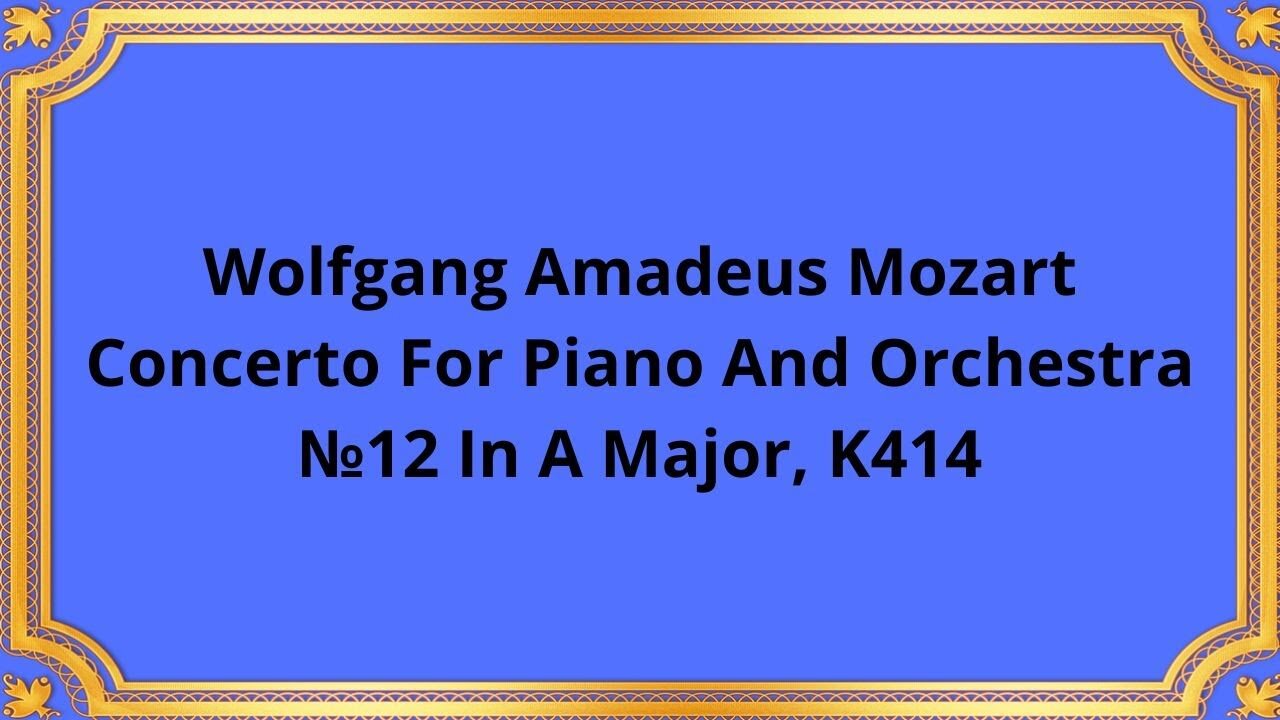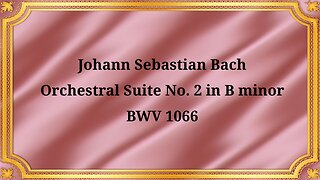Premium Only Content

Wolfgang Amadeus Mozart Concerto For Piano And Orchestra №12 In A Major, K414
#Mozart #ClassicalMusic #MusicComposition #PianoConcerto #OrchestralMusic #K414 #AFlatMajor #ClassicalPeriod #MusicHistory #MusicalGenius #Harmony #Counterpoint #Symphony #Virtuosity #MusicalInnovation
Publication date 1961
PRO MUSICA ORCHESTRA, VIENNA
Ingrid Haebler — Conductor: Heinrich Hollreiser
Wolfgang Amadeus Mozart's Concerto for Piano and Orchestra No. 12 in A Major, K414, is a remarkable musical composition that showcases Mozart's exceptional talent and mastery of classical music. Composed during the classical period, this concerto has captivated audiences with its melodic richness, technical brilliance, and the perfect interplay between the piano and orchestra.
Composed in 1782, Mozart's Concerto for Piano and Orchestra No. 12 in A Major, K414, holds a significant place in the classical period of music. This era, characterized by its pursuit of balance, clarity, and thematic development, witnessed a surge of creativity and innovation. Mozart, a prominent figure of the time, pushed the boundaries of musical expression with his ingenious compositions.
The concerto consists of three distinct movements, each showcasing Mozart's genius and compositional prowess.
1. Allegro: The first movement opens with a vibrant and spirited piano exposition, introducing the primary thematic material. Mozart's intricate melodies dance effortlessly with the orchestra, creating a delightful musical dialogue. This movement is characterized by its lively tempo, virtuosic piano passages, and the seamless integration of the soloist and the ensemble.
2. Andante: The second movement provides a serene and introspective contrast to the preceding movement. Here, the piano takes center stage, delivering a lyrical and expressive melody that evokes a sense of tranquility. Mozart's ability to evoke deep emotions through his music is evident in this tender and emotive movement.
3. Allegretto: The final movement brings the concerto to a joyful and exhilarating conclusion. It is marked by its lively tempo, playful melodies, and spirited exchanges between the piano and orchestra. Mozart showcases his technical brilliance through intricate passages and dazzling virtuosity, leaving the audience in awe.
Mozart's Concerto for Piano and Orchestra No. 12 in A Major, K414, exhibits several musical elements that highlight his innovative approach to composition.
1. Melodic Beauty: The concerto is adorned with captivating melodies that showcase Mozart's gift for crafting memorable and expressive musical lines. His ability to create melodies that resonate with the listener is evident throughout the piece.
2. Harmonic Sophistication: Mozart's harmonic choices in this concerto are both daring and innovative. He skillfully navigates through various tonalities, creating moments of tension and resolution that add depth and complexity to the music.
3. Orchestral and Piano Interplay: The concerto exemplifies the perfect balance between the piano and orchestra. Mozart seamlessly integrates the soloist with the ensemble, creating a harmonious and cohesive musical experience.
Mozart's Concerto for Piano and Orchestra No. 12 in A Major, K414, holds great historical significance as a testament to his unparalleled musical genius. It showcases his ability to combine technical virtuosity with emotional depth, leaving an enduring impact on the world of classical music.
Conclusion:
Mozart's Concerto for Piano and Orchestra No. 12 in A Major, K414, stands as a testament to his extraordinary musical talent and compositional brilliance. This timeless piece continues to captivate audiences with its melodic richness, technical prowess, and emotional depth. As we explore the structure, historical significance, and musical elements of this concerto, we gain a deeper appreciation for Mozart's contribution to classical music and his enduring legacy.
You have the opportunity to support the channel:
https://destream.net/live/RadSiarAl/donate
https://www.buymeacoffee.com/6355radsiaral
-
 20:26
20:26
Classical music_Music Inspiration
1 month agoJohann Sebastian Bach Orchestral Suite No. 2 in B minor, BWV 1066
772 -
 31:34
31:34
Friday Beers
2 hours agoOur Horrifying Night Drunk Ghost Hunting the Manson Murders
1.37K6 -
 40:48
40:48
The Kevin Trudeau Show Limitless
10 hours agoHow Karma Really Works (And How the Elites Use it)
140 -
 1:08:42
1:08:42
BonginoReport
4 hours agoDems Exposed For Hiding Hillary Clinton’s Poor Health - Nightly Scroll w/ Hayley Caronia (Ep.96)
113K54 -
 53:21
53:21
ZeeeMedia
4 hours agoAustralia's Abortion Rewards, Crypto Surge & Organ Harvest Horror | Daily Pulse Ep 72
12.3K3 -
 LIVE
LIVE
Playback Request Live
1 hour agoFrom Myspace to Rumble: Supmikecheck in the Creator Spotlight
41 watching -
 48:36
48:36
The Mel K Show
2 hours agoLive Q&A From Planet Chaos with Mel K 7-23-25
3.49K1 -
 LIVE
LIVE
WorldofGaming
19 hours agoMARIO KART 8 DX MULTIPLAYER MADNESS SPECIAL EDITION
19 watching -
 LIVE
LIVE
Saleen002003
3 hours ago🔴Live🔴 Bloodstrike S1-E1
20 watching -
 2:15:28
2:15:28
Barry Cunningham
4 hours agoPRESIDENT TRUMP MAKES SPEECH ABOUT AI
38.8K17